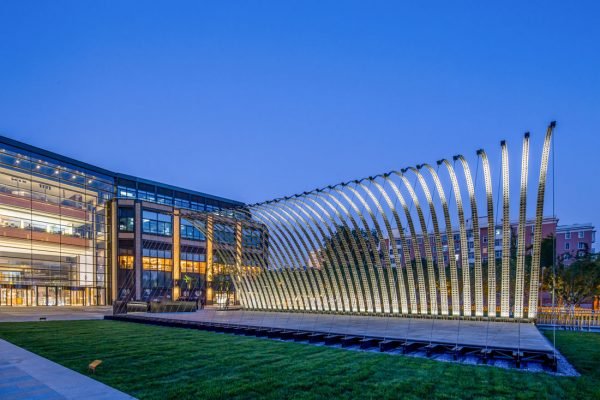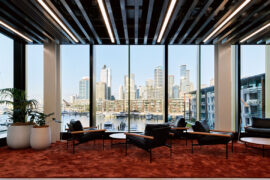The annual temporary arts pavilion makes its first foray outside of the UK in Beijing. Designed by Liu Jiakun, the structure has a barely contained energy that’s the result of cutting-edge mechanics.

June 8th, 2018
This year marks a new chapter in the Serpentine Pavilion’s journey: it’s the first year that the pavilion comes to Asia, and indeed, it’s the first year the pavilion appears anywhere outside of the UK. This year’s international pavilion opened on 29 May 2018, located on the green expanse in front of WF CENTRAL, Hongkong Land’s premium mixed-use development in Dongcheng District, Beijing.

The Serpentine Pavilion has been an annual fixture on the London summer arts scene, eagerly anticipated for the experiment approach each year’s commissioned international architecture firm will apply. Conceived by the Serpentine Galleries and launched in 2000, the pavilion has seen architects like Bjarke Ingels Group (BIG), Sou Fujimoto, Herzog & de Meuron, Rem Koolhaas and many others think outside the box to create temporary structures that invite people to engage with them and to take a different perspective.
For the first pavilion in China, the Serpentine Galleries sought the help of Liu Jiakun, Principal of JIAKUN Architects. Jiakun’s creation draws on the heritage of the Wangfujing area, as well as the 18-year history of the Serpentine Galleries.

“Working on the Serpentine Pavilion meant completing a project that requires a high-standard creativity in a limited time. Working on it in China, for me, means doing something that embodies both the Chinese spirit and a universal language,” says Jiakun.
To give the pavilion that ‘Chinese spirit’, Jiakun designed a dynamic form that resembles an archer poised to shoot an arrow from his bow. “The mechanical installation demonstrates a new structural concept: a series of layered spring steels, stacked thick at the bottom and thinner at the top, connected by bolts that play the role of ‘bow’.

Explains Liu, “Cables that work as ‘string’ pull the bow back, with the support of steel beams at the bottom as the ‘arrow’, to maintain balance. The elasticity and tension from the materials form an unsupported, self-stabilising structure that is full of inner energy.”
Powerful movement and balance: these elements counter each other in Jiakun’s thoughtful and precise design, making Beijing’s first Serpentine Pavilion a physical embodiment of junzi, a Confucian concept pursued by the “superior man,” says Jiakun.

The architect also drew on the form and materials of the nearby Forbidden City, paying tribute to China’s heritage. He used “jin zhuan, a special floor tile used for the Forbidden City in ancient China and fired in the southern region of the Yangtze River,” he says, and he referenced the arched forms of the Forbidden City’s roofs. “In line with the architectural design of the Forbidden City, we used anti-warping methods, echoing the cornices of China’s traditional roofs.”
The resulting structure is dynamic and beautiful in its apparent simplicity – and yet Jiakun says the sense of movement was harder to achieve than it looks. He explains, “The new structural mechanics, the ‘bow-arch structure’… seems simple, but actually, it required calculations and testing at every step of the way.”
INDESIGN is on instagram
Follow @indesignlive
A searchable and comprehensive guide for specifying leading products and their suppliers
Keep up to date with the latest and greatest from our industry BFF's!

The undeniable thread connecting Herman Miller and Knoll’s design legacies across the decades now finds its profound physical embodiment at MillerKnoll’s new Design Yard Archives.

Rising above the new Sydney Metro Gadigal Station on Pitt Street, Investa’s Parkline Place is redefining the office property aesthetic.

London-based design duo Raw Edges have joined forces with Established & Sons and Tongue & Groove to introduce Wall to Wall – a hand-stained, “living collection” that transforms parquet flooring into a canvas of colour, pattern, and possibility.

As French-Lebanese Architect Lina Ghotmeh prepares for lectures in Melbourne and Sydney, we hear about the philosophy shaping her internationally celebrated practice.

Spectacular architectural pavilions are big crowd-pleasers, but critics claim they’re running out of control.
The internet never sleeps! Here's the stuff you might have missed

Warren and Mahoney’s design for Beca’s Auckland headquarters turns the mechanics of engineering into poetry, rethinking how workplace design can reveal its own systems.

Recognised as a winner at the INDE.Awards 2025, Barton Taylor has received The Photographer – Residential accolade. His photographic work on Cake House captures the soul of a coastal icon reimagined, blending light, texture and atmosphere into a compelling visual narrative.